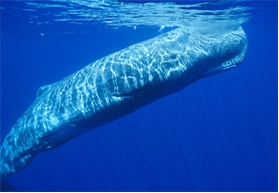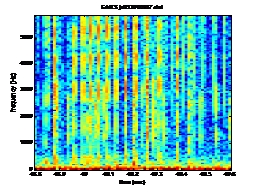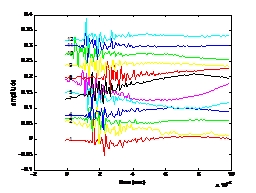Clicking Whales Who is Talking?
George E. Ioup - geioup@uno.edu
Juliette W. Ioup, Lisa A. Pflug
Department of Physics, University of New Orleans
New Orleans, LA 70148
Christopher O. Tiemann, Alan Bernstein
Applied Research Laboratories, University of Texas at Austin
Austin, TX
Natalia A. Sidorovskaia
Physics Department, University of Louisiana at Lafayette
Lafayette, LA
Popular version of paper 1aSP3
Presented Monday morning, October 26, 2009
158th ASA Meeting, San Antonio, TX
Toothed whales (odontocetes), including sperm and beaked whales, emit very loud clicks into the water. They do this in order to echolocate: they listen to the echoes from the surface and the bottom to know where they are in the water column, and they listen to echoes from their prey in order to locate their food. A fascinating research question is whether whales can tell which of their comrades is clicking from subtle differences in the clicks emitted by each whale. A very interesting related question is whether humans who are also listening can identify each whale from the properties of their clicks. Sperm whales, which have very large heads (up to 20 ft long) and emit extremely loud clicks, are especially intriguing because they also emit clicks which are thought to be used for communication purposes. A group of these clicks, called a coda, is 6 to 15 clicks in a row and spans about half a second.
We study both the time properties of the individual clicks and also their properties after they are analyzed into component waves of different frequencies (the way the human ear analyzes sounds). These techniques, collectively referred to as cluster analysis, associate similar codas or echolocation clicks with each other assuming similar clicks come from the same whale, and results so far are promising. What is needed is a way to know if our associations do indeed correspond correctly to individual whales. Therefore, we have begun to locate the whales acoustically at the same time we are identifying them, thus confirming that clicks do come from the same whale. If our identifications of individual whales are verified, the research can have significant benefit both for behavioral studies of the whales and for population estimation.

Figure 1. Sperm whale

Figure 2. Analysis of the clicks of one coda into waves of different frequencies. Clicks are vertical lines plotted versus time on the horizontal axis. The vertical axis shows the frequency. The color shows the contribution of waves at each frequency. Red corresponds to the most intense and blue to the least intense. Notice that the pattern versus frequency persists across all clicks in the coda. Other codas have clicks which are similar to each other and can either be the same or different from these.

Figure 3. Amplitude (pressure received at the hydrophone) plotted versus time for different clicks within one coda. The vertical axis is offset for each click so that they can be viewed more clearly. The clicks are similar to each other. Other codas have clicks which are similar to each other and can either be the same or different from these.